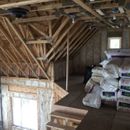How to insulate valleys in a cathedral ceiling to avoid ice dams?
We’re in a maritime climate on the west coast of Newfoundland, Canada. Climate is zoned as 6 but we have mild winters with averages around -10 C. We get warm spells followed by cooler days, not your average climate 6 winter.
We’re really struggling with how best to insulate our roof, the plans call for 2 layers of R20 batt insulation with an interior vapor barrier (poly) before drywall on the flat ceiling and T&G pine on the slopes… But we don’t feel comfortable with this avenue. The roof pitch is 12:12. Parallel chord truss, 24″ o.c., 25″ deep, with 4 valleys: see picture. Continuous ridge vent and soffit vents.
We’re thinking of caulking vents to the roof deck, attaching mesh to the trusses and filling the cavities with blow in Fiberglas insulation. The issue arises at the valleys which would be impossible to properly vent and are considering spraying the valleys with 5″ of 2lbs closed cell spray foam.
No inspection is required in this remote location.
What are your thoughts on this proposed approach? Would you advise to do differently?
Many thanks for any input!!
Oliver
GBA Detail Library
A collection of one thousand construction details organized by climate and house part










Replies
This picture was meant to be uploaded. Also, wood and electric furnace as heat so the rh should be low, also have hrv
Oliver,
For a full explanation of all of the different ways to insulate a cathedral ceiling, see How to Build an Insulated Cathedral Ceiling.
A few comments:
1. You need a good air barrier on the interior side of this kind of roof assembly. Tongue-and-groove pine boards do not create an air barrier. The usual solution is to install a layer of taped drywall before you install the T&G boards. Pay attention to airtightness -- no recessed can lights allowed.
2. Roofs with valleys aren't good candidates for vented assemblies. Because of these valleys, an unvented assembly makes more sense than a vented assembly.
3. You are correct to worry about thermal bridging at the framing lumber under valleys. The best solution to this type of thermal bridging is to install a thick layer of rigid foam above your roof sheathing.